When people think of fitness, they often picture heavy weights, intense workouts, and sweat-drenched sessions. While training is essential, what many overlook is that true progress happens outside the gym—during recovery. Recovery is not just rest; it is an active process that allows the body to repair, adapt, and grow stronger. Ignoring it can stall progress, invite injuries, and ultimately derail long-term health goals.
Why Recovery Matters
Every workout is a form of stress. Lifting weights creates tiny tears in muscle fibers, running taxes joints and tendons, and high-intensity training depletes energy reserves. Recovery is the phase where these stresses are repaired and adapted into strength, endurance, and resilience. Without adequate recovery, the body remains in a constant state of breakdown rather than growth.
Think of recovery as the balance to exertion: training challenges the body, recovery transforms that challenge into improvement. Together, they form the complete cycle of fitness.
Types of Recovery
Recovery is more nuanced than just taking a day off. It comes in multiple forms, each playing a critical role in long-term performance:
-
Sleep: Perhaps the most underrated tool. During deep sleep, growth hormone is released, fueling tissue repair and muscle growth. Poor sleep not only slows recovery but also increases the risk of injury and impairs decision-making.
-
Active Recovery: Gentle movement—like walking, yoga, or swimming—enhances circulation, flushing out metabolic waste while delivering nutrients to muscles. It helps you feel less stiff and accelerates healing.
-
Nutrition: Fueling the body with protein, complex carbs, and healthy fats post-workout replenishes glycogen stores and provides the raw materials for muscle repair. Hydration is equally crucial to support cellular function and recovery.
-
Mobility and Stretching: Dynamic stretches and mobility drills improve range of motion and prevent the buildup of tightness that can lead to injuries.
-
Mind-Body Practices: Stress management through meditation or breathwork can reduce cortisol levels, which, when chronically high, interfere with recovery.
Common Mistakes in Recovery
Many fitness enthusiasts fall into the “more is better” trap, believing that progress comes from pushing harder every day. But overtraining is real—it leads to fatigue, mood swings, plateaus, and even long-term damage to joints and muscles. Another mistake is inconsistent recovery: neglecting sleep during the workweek and trying to “catch up” on weekends doesn’t provide the same benefits as consistent, high-quality rest.
Recovery as a Lifestyle
What makes recovery unique is that it’s not confined to the gym—it’s part of your daily lifestyle. Setting a bedtime routine, fueling your body with whole foods, staying hydrated, and scheduling downtime are as critical as the workouts themselves. Athletes often say, “Train hard, recover harder,” because they know recovery determines how far they can push their limits.
The Takeaway
Fitness is not just about effort; it’s about balance. Recovery transforms sweat and strain into strength and stamina. It is the quiet, unseen work that makes visible progress possible. By giving recovery the attention it deserves—through sleep, nutrition, active rest, and mindfulness—you’re not just avoiding burnout, you’re setting the stage for sustainable fitness and lifelong physical health.
So the next time you plan your workout, remember: growth doesn’t happen when you lift the weight, but when you recover from lifting it.

